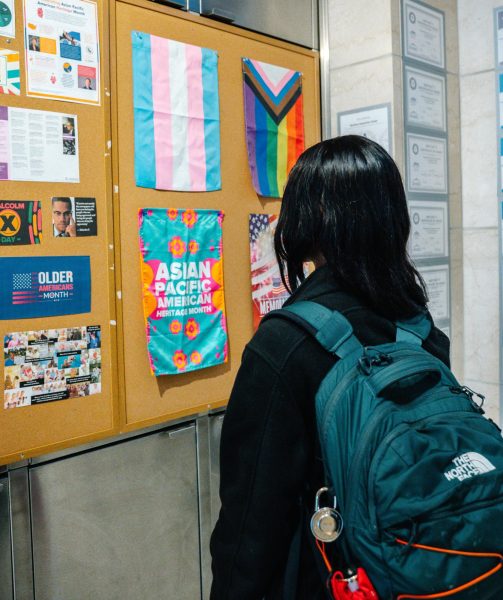The trend of thrifting
October 2, 2020
Ask nearly any teenager nowadays, and they will probably tell you that some of their clothing in their closet has been thrifted. Thrift shopping has risen in popularity among younger generations for many reasons, such as the inexpensive prices, the opportunity to find unique clothes, and ability to reduce fast fashion purchases. However, this new fad may not be as wonderful as it appears on the surface.
Thrift store “hauls” by YouTubers skyrocketed in popularity in April 2020. From there, these hauls moved to TikTok, where they have only gained more attention. Thrifting has become an extremely popular trend to do. Thrift stores had once been seen as a location primarily for the lower classes to find clothes, and while many lower-income families still rely on second-hand stores to purchase most of their clothes, influencers have caused the wealthier classes to frequent these stores as well. For some lower class individuals, thrifting is a necessity, while for some higher-income shoppers it is a fun scavenger hunt (1).
In the modern world, thrifting can satisfy ever-changing fashion trends. Many people cannot afford to buy a new wardrobe once influencers and fashion companies decide what’s new. Teenagers will instead go to thrift stores in search of something to match these trends, all while saving a few dollars. According to ThredUp’s 2019 resale report, one in three Gen Z teens shop from second hand stores (1). The rise in thrifting among this generation is due to many reasons, such as the desire to buy new clothes at inexpensive prices, to reduce their carbon footprint, and to ditch fast-fashion. Its popularity is only going to increase within the next five years. As more teenagers find out the dangers that the clothing industry imposes to the environment, the demand for secondhand clothing will only increase. Freshman Vanessa Saintvil here at UMass Boston explains why she enjoys thrifting, saying, “I like knowing that I can find something someone else won’t have. Also, thrifting is great for the environment.”
While all this business can benefit the owners of the thrift stores, it can in turn hurt those who need to shop at second hand stores. Supply and demand must be met, and as goods are being purchased at a heavy rate, their prices will go up. The most this will do is be a bother to those who can afford to shop elsewhere, while on the other hand, it can seriously harm lower-income families who can only shop at these stores. “I feel like the prices are going up,” said freshman Sarah Scribner. “And for people who don’t have a lot of money, it could be a struggle to buy clothes.”
As reselling apps like Poshmark and Depop gain popularity, some teens are seeing these apps as a way to make money without having a traditional job. These teenagers will buy clothes for a few dollars apiece, only to sell them for triple the value. One Depop seller, for example, found a mini backpack for three dollars at her local Goodwill and sold it for $70 on her Depop (2). “Personally I’m not a huge fan [of resellers],” said junior Matt Toon. “I think it defeats the purpose of it, especially in the case of lower-income families that rely on thrift shop clothing. It takes away an opportunity for a kid to get the jersey of his favorite athlete or someone to miss out on a great outfit for a date.”
Online websites dedicated to resale shopping also capitalize off of this rise in thrift shopping. Websites like Goodfair profit on the want for thrifted clothes and on Gen Z’s desire to shop from their home in their pajamas. Goodfair’s premise is simple—buyers pick a random mystery style box of thrifted clothing in their size, and the box gets shipped to the buyer, with box prices ranging from $15 to $85 for bundles (4).
When surveyed, forty-four percent of Beacons who thrift shop have said that they shop on online thrift shop sites. In addition to Goodfair, other websites like ThredUp and Refashioner, as well as apps like Depop and Poshmark also supply thrifted clothes from an online platform. Furthermore, some thrift shoppers, especially ones that fit in smaller sizes, will shop in the larger sections to crop a hoodie or shirt. A problem with these thrift shoppers can be that larger sizes will be harder to find in thrift stores in comparison to standard sizes, and again leaving fewer resources for lower-income families who may need these sizes (3).
As thrift stores are gaining in popularity, traditional retail stores are declining in popularity. While retail chains have been closing locations or filing for bankruptcy altogether, the resale market is expected to double within the next five years (2). Teenagers no longer want the same clothes that all of their peers can have, and instead want more unique looks. This again is leaving even fewer options for everyone else and those who need it. Retail stores have become extremely accessible to people of all shapes and sizes that the resale market struggles to cater to. General department stores have petite and plus-size sections. Trendy stores for teenagers like American Eagle and Hollister have tall and short selections in their pants and dresses. The thrifting market allows shoppers to find rare and exclusive pieces to add to their collection. A vintage sweater or lightly worn Dr. Martens can brighten up any wardrobe, as can a pair of brightly colored corduroy pants. However, these opportunities have not been distributed fairly to all people, due to limited sizing.
Overall, MFA student Jamie Chernoch says it best: “I think thrifting can be fun and sustainable, but it has gotten out of hand with the resellers”.
1.) https://www.statepress.com/article/2020/03/spmagazine-the-thrift-economy
2.) https://www.thecut.com/2019/08/depop-app-gen-z.html
3.) https://econreview.berkeley.edu/rise-of-thrifting-solution-to-fast-fashion-or-stealing-from-the-poor/
4.) https://goodfair.com/





























































